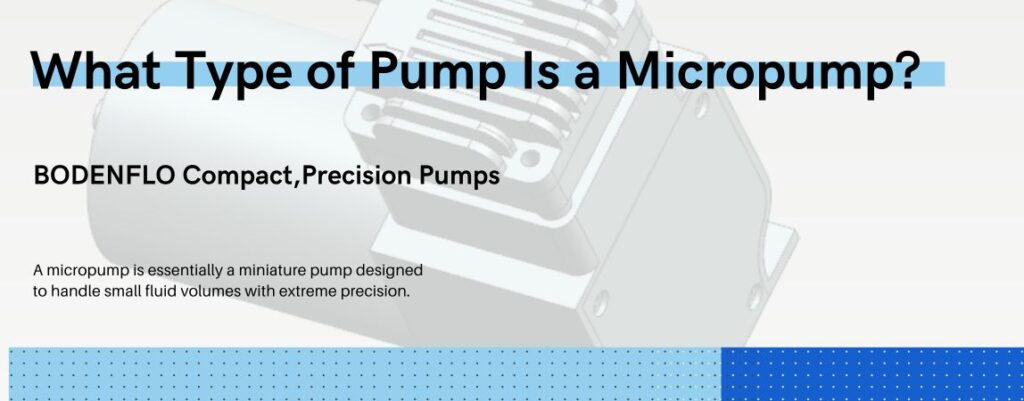
You're facing problems of compact space, yet high-performance requirements in your project. Perhaps you've heard the term "micropump" but are not sure what it exactly entails or if it's the right solution for your needs.
A micropump is essentially a miniature pump designed to handle small fluid volumes with extreme precision. It serves as a compact yet efficient solution for various applications ranging from medical to industrial uses.
This post aims to demystify what a micropump is, its types, and its plethora of applications. Intrigued? Stick around as we dive into the minute details of micropumps.
What Makes a Pump a Micropump?
When we talk about pumps, we often envision large mechanical systems used in various industrial applications. But what about micropumps? As the name suggests, these are miniaturized versions, yet they are an entirely different beast when it comes to functionality and scope of applications. Let's delve deeper to understand what sets a micropump apart from its full-sized counterparts.
Size and Precision
First and foremost, micropumps distinguish themselves through their compact dimensions. Often measuring less than an inch in each direction, these pumps are designed to fit into highly specialized environments where space is at a premium.
Fluid Control Mechanisms
Micropumps are engineered for exceptional fluid control, offering accuracy that is often required in critical applications such as medical devices and lab-on-a-chip systems. The architecture inside a micropump—be it a piston, diaphragm, or piezoelectric element—is intricately designed to offer precise control over fluid dynamics.
Material Selection
Another feature setting micropumps apart is the range of materials from which they can be manufactured. Specialized materials like PEEK or PTFE are often employed to offer chemical resistance, durability, and biocompatibility.
Energy Efficiency
Their small size not only makes them space-efficient but also often translates to less energy consumption compared to larger pumps, making them ideal for battery-operated or portable applications.
A micropump is more than just a miniaturized pump. It's a highly specialized device engineered for precision, efficiency, and adaptability, meeting the rigorous demands of various critical applications.
How Do Micropumps Work?
In the realm of fluid dynamics and control systems, the micropump stands as a marvel of engineering precision. However, one may wonder how these miniature devices manage to accomplish their tasks with such exactitude. Let's dissect the working mechanisms that govern these specialized pumps.
Design Complexity in Simplicity
At first glance, a micropump may appear simple, but the underlying technology is intricate and complex. Depending on its specific use-case, a micropump can employ various mechanisms like diaphragms, pistons, or piezoelectric elements to move fluid. Each of these mechanisms serves a different need and is selected based on the precision and flow rate requirements of a particular application.
Precision in Flow Rates
Because of their diminutive size, the internal components of a micropump are finely tuned to deliver exact flow rates. This is crucial for applications that require precision in fluid transfer, such as drug delivery systems, microfluidic devices, and lab-on-a-chip technologies. The engineering behind these components often involves high-end simulations and real-world testing to achieve the desired performance metrics.
Control Systems
Another distinguishing feature is the advanced control systems these pumps incorporate. Often, they are equipped with feedback loops and sensors that adapt the pump's operation in real-time, offering unparalleled control over fluid dynamics.
Material Considerations
Finally, the materials chosen for these pumps are also tailored to their specific applications, often including chemically resistant or biocompatible selections to safely handle sensitive or corrosive fluids.
The operational mechanics of a micropump are a blend of intricate design, precise engineering, and specialized materials. These elements converge to make micropumps incredibly effective and reliable in their respective applications.

What Type of Pump Is a Micropump?
The landscape of fluid control technology has seen remarkable advancements, and one of the pivotal innovations is the micropump. These aren't merely scaled-down versions of conventional pumps; they are meticulously engineered devices with unique capabilities, designed to meet specific challenges that larger pumps can't address. In this section, let's delve into what exactly constitutes a micropump and why they have become an integral part of various industries.
Compact Dimensions
Micropumps are characterized by their extremely small dimensions, usually less than an inch in all directions. This compactness is not just for the sake of miniaturization but serves practical purposes. Their small footprint allows them to be integrated into devices and systems where space is a premium, yet the requirement for precise fluid control is non-negotiable.
Precision and Control
What sets micropumps apart is their unparalleled ability to control fluid flows at minute levels. Whether it's the accurate dispensing of medication in medical devices or the precise control of reagents in analytical instruments, micropumps deliver unmatched precision. This is enabled through sophisticated mechanisms like diaphragms and piezoelectric actuators that are fine-tuned for their respective applications.
Specialized Applications
Micropumps are not general-purpose devices; they are often built for highly specialized applications. This could range from handling hazardous chemicals in industrial settings to administering accurate doses in implantable drug delivery systems. Their design often incorporates materials and configurations optimized for specific fluidic properties, such as viscosity and chemical compatibility.
Micropump are far more than miniaturized pumps; they are specialized devices engineered to perform specific tasks with extreme precision and reliability. Their compact size and high adaptability make them indispensable in a variety of cutting-edge applications.
What Are the Different Types of Micropumps?
In the realm of fluid dynamics and control, micropumps have emerged as specialized tools that fill gaps unaddressable by their larger counterparts. They're not just miniature pumps; they're highly specialized devices engineered for precise applications. So, what types of pumps fall under the umbrella term of 'micropump'? Let's explore this in detail.
Mechanical Micropumps
Micro Diaphragm Pumps
One of the most common types of mechanical micropumps is the micro diaphragm pump. These pumps use a flexible diaphragm that oscillates back and forth, generating suction and expulsion phases to move fluids. They're particularly effective for chemical dosing and medical applications.
Micro Piston Pumps
Another mechanical type is the micro piston pump. Similar to diaphragm pumps, piston pumps utilize a reciprocating piston to draw in and expel fluids. These are generally used where high pressure and accuracy are required.
Non-Mechanical Micropumps
Electroosmotic Pumps
In contrast to mechanical pumps, electroosmotic pumps utilize electrical fields to move fluids through porous media. They are often used in microfluidic applications where precise control of tiny fluid volumes is crucial.
Thermopneumatic Pumps
Thermopneumatic pumps rely on temperature changes to generate pressure differentials, thus moving fluids. These are generally used in specialized industrial applications or in scientific research.
Electrokinetic Micropumps
These pumps use electric fields to induce fluid movement, often leveraging phenomena like electrophoresis or electroosmosis. These are particularly useful in lab-on-a-chip systems, where minute but accurate fluid handling is necessary.
Micro pumps can be broadly categorized into mechanical, non-mechanical, and electrokinetic types. Each comes with its own set of advantages, disadvantages, and ideal use-cases. Understanding these types can help you make an informed decision when choosing a micropump for your specific application. Whether you need precise flow control for a medical device or robust performance for an industrial application, there is likely a micropump tailored to meet those needs.
Comparative Analysis
Each type comes with its own set of advantages and disadvantages. Mechanical pumps excel in robustness and flow control but can be bulkier. Non-mechanical and electrokinetic pumps offer excellent miniaturization but may require more complex control systems.
The world of micropumps is diverse, each with its unique set of characteristics tailored for specific applications. Understanding these differences is crucial for selecting the most suitable micropump for your project needs.

What Are the Applications of Micropumps?
The ubiquity of micropumps across various industries underscores their indispensable nature in modern technology. These miniature devices excel in applications where precision, reliability, and compactness are paramount. Here, we will explore some of the key areas where micropumps are making a significant impact.
Medical Devices
In the medical field, micropumps are often used for controlled drug delivery systems. Their ability to deliver precise dosages of medication over extended periods makes them invaluable for treatments like insulin delivery for diabetics or chemotherapy for cancer patients. The precision ensures that the drug efficacy is maximized while minimizing potential side effects.
Chemical Analysis
Micropumps are fundamental components in many analytical devices, like gas chromatographs and mass spectrometers. They can handle minuscule amounts of samples and reagents with high accuracy, allowing for intricate chemical analyses. This is particularly useful in forensic labs, environmental monitoring, and quality control in various industries.
Lab-on-a-Chip Devices
These are miniaturized laboratories that can perform multiple functions, such as sample preparation, reaction, and analysis, on a single chip. Micropumps are used to control the flow of liquids through the microchannels on the chip. This technology has applications in point-of-care diagnostics, DNA sequencing, and many other bioanalytical processes.
Electronics Cooling
Beyond the more obvious applications, micropumps also find use in cooling systems for electronics. In devices that generate significant heat, like CPUs and GPUs, micropumps can circulate a coolant to dissipate heat efficiently, thus prolonging the device's lifespan.
Micro pumps offer a wide range of applications across various sectors due to their precision, reliability, and compact form factor. Their capabilities extend far beyond what their size might suggest, making them an essential component in modern technology.

How to Choose the Right Micropump?
Selecting the appropriate micropump is not merely a task; it's an exercise in precision engineering. Making the right choice can significantly influence the performance and efficiency of your application. Whether it's for medical, industrial, or laboratory use, choosing the wrong pump can result in inefficiencies that could compromise the entire system. Here's a comprehensive guide on the crucial parameters to consider.
Flow Rate and Pressure Requirements
Understanding the flow rate and pressure requirements of your specific application is crucial. For instance, if you require a micropump for medical applications like drug delivery, the pump should be capable of delivering very low yet accurate and consistent flow rates.
Sizing and Space Constraints
Before making a choice, evaluate the physical space the pump will occupy. In applications where size is a constraint, like wearable medical devices, the compactness of the micropump becomes crucial.
Fluid Compatibility
It’s essential to assess the nature of the fluid to be pumped. Chemical compatibility could play a significant role in the longevity of the pump. At BODENFLO, we offer pumps with various material options to ensure compatibility with a wide range of fluids.
Customization and Scalability
At BODENFLO, our range of micropumps is not just extensive but also customizable. We offer features like 3-24V DC power options, adjustable pressure ranges from -30 to -95kPa, and flow rate customization from 0.3 to 70L/min. These options allow for scalability and integration into diverse systems, ensuring you have a pump that perfectly matches your application's unique needs.
In summary, choosing the right micro pump involves an intricate evaluation of your application's specific demands, and at BODENFLO, we strive to provide solutions that are as versatile as they are efficient.
Conclusion
Micropumps are miniaturized pumps that offer precise control over fluid flow, making them indispensable in various specialized applications. Whether you’re in the medical field, manufacturing, or any other industry requiring precise fluid control, there’s likely a micropump perfectly suited for your needs.


